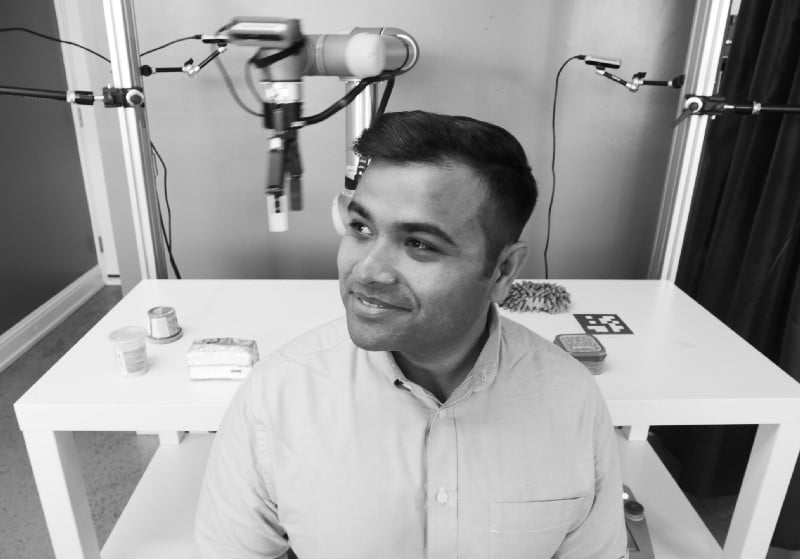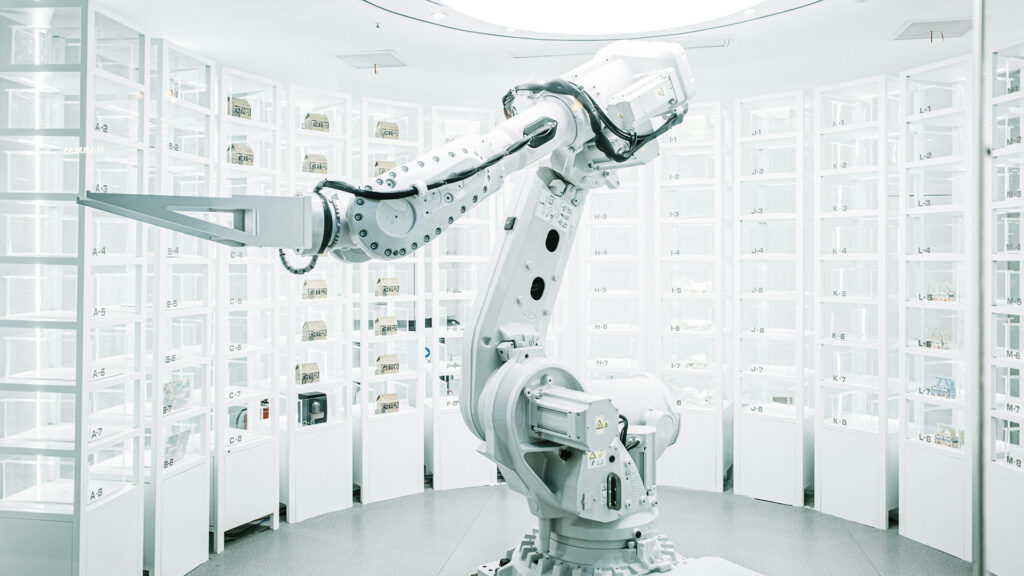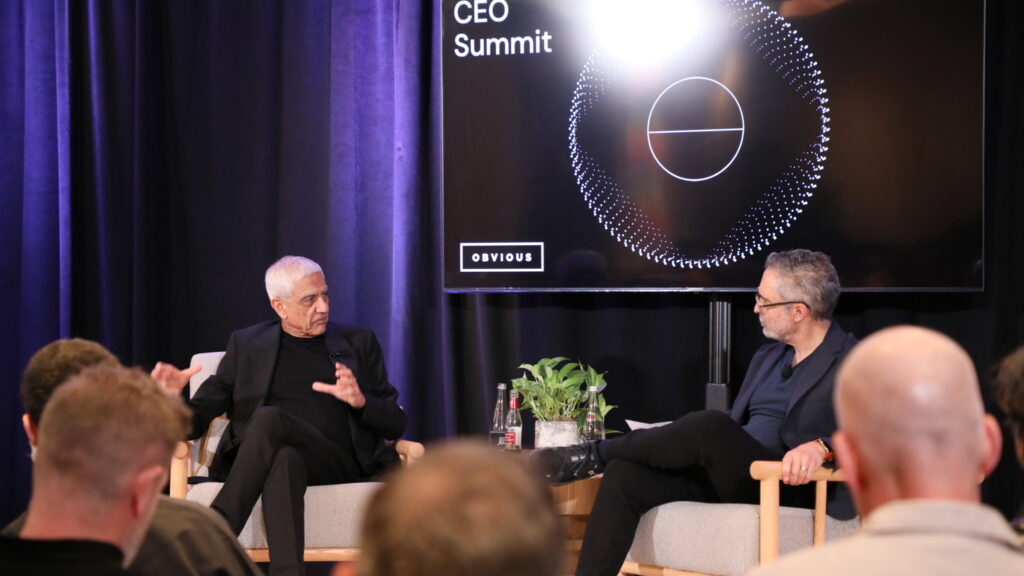These Robots Learn. Meet Their Teacher.
Dexterity CEO Samir Menon draws on neuroscience, mathematics, and computer science to build robots of the future, today. He’s also a poet.
Obvious |

We’re nearly an hour into our conversation when Samir asks me to stand up.
“Stick out your finger,” he says. I tilt my head with a grin, and he returns the volley with a beaming “Trust me!” smile.
How can I say no?
In an E.T.-like gesture, Samir raises his hand, deliberately extends his index finger to meet mine, and begins pushing. Without thinking, I push back. That’s when the lesson begins.
“Did you know you have 46 muscles in your arm? You aren’t trying to control all 46 to push on my finger, right? You need to coordinate your body to achieve purposeful control at some specific point that you care about. Your fingertip. Holding something. Kicking something.”
He proceeded to wax poetic not only about neuroscience, but philosophy, mathematics, and the history of labor for the remainder of our time together. I was fascinated by how little we actually dove into robotics, given that Samir co-founded a robotics company.
To understand Samir Menon’s approach as CEO of Dexterity is to know that it was formed over decades by a deeply sophisticated worldview.
When he first joined the Computer Science program at Stanford, Samir recognized that most software engineers don’t know what’s in the hardware they use every day. He gushed about the modern marvel that are computers as if he had just seen one for the first time:
“How do these gears work? It’s mind boggling when you think about it! One program after another, an insane cascade, you push a button and it all lights up. The digital revolution is difficult to understand, but we’ve grown so accustomed to it because we grew up in it.”
As he moved from Master’s to PhD, Samir recognized the importance of clarity when deciding what to do with the degree. The choice for many on an academic track, according to him, was to either keep it theoretical or dive more concretely into real world application. He pursued the latter, because it was “what’s in my heart.”
“I realized academia wasn’t enough. It was incumbent on me to execute…to go out there and make an impact. To help increase productivity in the labor force, tackle the problems of an aging workforce, and help people who are doing tedious jobs.”
Working backward — to develop robots that were revolutionary, and yet deployable in a real-world context — he required a deeper knowledge of neuroscience and mathematics.
“I had to understand mathematics, how humans move, and how the brain works. So I merged all of them.”
And with that, his thesis was born: A control theory framework to describe how the brain controls and coordinates the body. Samir credits his advisors, Kwabena Boahen and Oussama Khatib, as the chief proponents of this approach, one that led to them capturing the essence of what it means to move in a human-like manner— and ultimately, enabling robots to do the same.
The confluence of these fields isn’t without its fundamental challenges. The real world — the physical world — is tough.
“Though you might live the dream in a digital world, you still have to confront the physical world. You want a perfect computer vision program? What happens when there’s dust in the air? Even with [generous] time and resources, the real world is what it is. Deploying something that’s going to have an impact is harder than it seems. Execution is a beast unto itself.”

Samir grew up in Dehradun, India, about 150 miles north of Delhi where “the serious mountains start.” It is a small town by Indian standards: just over half a million people.
His childhood was devoid of television, and instead awash in books. His family’s eclectic preoccupations influenced him in innumerable ways: Samir’s father is a poet and a writer, his mother studied particle physics in graduate school, while his sister pursued a career in journalism with stints as Managing Editor of Elle in India and as a senior reporter for the Hindustan Times. His wife studied cellular and molecular biology and is an early-stage startup veteran twice over. Samir himself continues to write poetry today, incorporating the practice into his recruiting process.
As science fiction aficionados, he and his father were obsessed with the merger of machines and humans in the future. With Isaac Asimov’s positronics on the brain and the computer revolution sprouting up around them, these visions of the future converged on their household. They bought a personal computer, which at the time cost more than a car. “It had its own share of wonder — it was a magic box,” he explains. With the purchase his father plainly declared that his kids were going to be a part of the future.
By the time he was seven Samir knew how to code on a PC. “My first noteworthy program was Tic Tac Toe. I could write a program where the computer never loses. From there I drifted into computer gaming, and it became very clear that I wanted to study computer science.”
When graduating from 12th grade, Samir was placed in a CS program. That wasn’t enough for him, as the Indian academic system didn’t afford the opportunity to “touch the edge of technology,” with Indian industry lacking infrastructure for robotics and hardware more broadly. So where to? The United States was the clear winner.
“Technology is driving change here. It’s a welcoming society, and it’s a meritocracy in some sense if you work hard. It doesn’t hurt that Stanford is the top-ranked school for computer science in the world.”
Boahen’s and Khatib’s work is what inspired him the most.
“While considering Stanford, I saw on Kwabena Boahen’s site, Brains In Silicon, that they were building brain-like chips. He had funky people in the lab like John Arthur and Paul Merolla. Stanford was also home to Oussama Khatib who made many foundational contributions to robotics. Brains, chips, robots, humans, AI, neural networks — I mean, c’mon! If you merge all of this together, how can you not be excited?”
And while his entry-point was a Master’s in CS, he knew he wanted to pursue a PhD — and robotics as well. “I’ve been a purposeful person for quite a while,” he says with a laugh.
Purpose, it turns out, is foundational to Dexterity. It comes with deep, ongoing reflection. I ask why, and Samir moves seamlessly into a higher order line of rhetorical questions.
“What’s the best way for us to introduce automation into society? If we go back in history, there was this idea of workmanship. That there are individuals with talents, and they apply those talents to produce goods. [But] if you take a modern day mechanized job, it’s the same every single day.
“In our society today, people go to a warehouse and pick and place objects all day long. Imagine, instead, if they applied instead for a job to operate five robots, and their role is to coordinate and train the robots. Is that better? What if robots could understand language so well that anyone could train them? What are the consequences? Imagine if we had that?”
This all leads to why Samir is doing what he’s doing at Dexterity.
“At the moment, society is at a point where we can use technology to automate many mechanical, tedious, and repetitive jobs. Fewer and fewer people want to do them, yet society relies upon them being done. The opportunity is for us to deploy automation in a way that fills a need and has a positive impact without disrupting existing labor force patterns.
“We have a lot of comforts in life, but we also have a lot of constraints. If we can increase productivity where humans can direct their attention to stuff they want to do, and not a repetitive life, maybe it can improve people’s lives.”
As we wrap up, I’m struck by Samir’s heightened self-awareness. These are complex, dynamic, and often controversial topics — especially now in Silicon Valley. This level of awareness is critical to success today.
“Human beings have many perspectives, and my perspective may not represent their reality. I should listen. Paying attention to others is necessary to succeed in a role where the bulk of your job is to interact with people, get them to communicate with one another, and develop a sense of purpose together. It seems obvious, but putting that into action is incredibly hard.”



